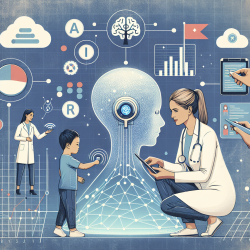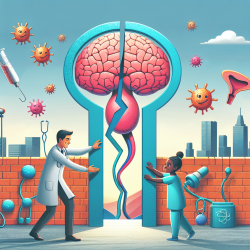Introduction: The AI Revolution in Speech-Language Pathology
Artificial Intelligence (AI) is rapidly transforming various domains within healthcare, including speech-language pathology. As a practitioner dedicated to improving child outcomes, understanding the implications of AI can be pivotal. The recent scoping review on AI's influence in nursing provides valuable insights that can be adapted to speech-language pathology, particularly in online therapy services like those offered by TinyEYE.
Harnessing AI for Enhanced Child Outcomes
The review highlights AI technologies such as predictive analytics, virtual assistants, and robotics, which are already influencing healthcare roles and workflows. In speech-language pathology, these technologies can be leveraged to enhance therapeutic outcomes for children by:
- Predictive Analytics: Utilizing machine learning to analyze data and predict speech and language development trajectories, allowing for personalized intervention strategies.
- Virtual Assistants: Implementing AI-driven virtual assistants to provide real-time feedback and support during therapy sessions, improving engagement and outcomes.
- Robotics: Using socially assistive robots to engage children in interactive therapy activities, fostering motivation and participation.
AI's Role in Compassionate Care
AI technologies have the potential to enhance compassionate care by freeing up practitioners' time to focus on building therapeutic relationships. By automating routine tasks, practitioners can devote more attention to understanding and responding to each child's unique needs, thus fostering a more personalized and empathetic approach to therapy.
Ethical Considerations and Policy Implications
As AI becomes more integrated into speech-language pathology, it is crucial to address ethical considerations and policy implications. Practitioners must advocate for ethical AI use that aligns with core values of compassionate care, ensuring that AI augments rather than replaces human interaction. Policies should be developed to protect patient privacy and data security, particularly when using AI-driven tools in online therapy settings.
Encouraging Further Research and Collaboration
To fully realize AI's potential in speech-language pathology, ongoing research and collaboration are essential. Practitioners should engage with interdisciplinary teams, including data scientists and AI developers, to co-design AI tools that meet the specific needs of children in therapy. By contributing their expertise, speech-language pathologists can ensure that AI technologies are developed with a focus on enhancing therapeutic outcomes and maintaining compassionate care.
Conclusion: Shaping the Future of Speech-Language Pathology
The integration of AI into speech-language pathology offers exciting opportunities to enhance child outcomes and improve therapeutic practices. By embracing AI-driven insights and advocating for ethical implementation, practitioners can lead the way in transforming online therapy services. As we look to the future, continued research and collaboration will be key to shaping a compassionate, data-driven approach to child development.
To read the original research paper, please follow this link: Predicted Influences of Artificial Intelligence on the Domains of Nursing: Scoping Review.










